
The only thing better than the crispy coating on well-prepared fried chicken is more of it. At least half of all fried-chicken love goes toward the crust, and although the moist, juicy meat inside is great, it wouldn't seem nearly as good if it didn't contrast with a crispy crunch.
You have to modify the standard breading procedure and choose the best fat to get a crust that doesn't overpower the chicken, and fries up crisp instead of chewy. This means using both a light wet ingredient, such as buttermilk, and a thicker wet ingredient, such as frothy egg wash, and trading the shortening for light oil.
Step 1
Cover the chicken pieces with cultured buttermilk, or two cups per chicken, in a baking dish or food storage container. Marinating in buttermilk improves tenderness and adds a bit of tang to the flavor, but is optional.
Step 2
Cover the container with food wrap. Marinate the chicken for about two hours on the bottom shelf of the refrigerator.
Step 3
Pour an inch or two of all-purpose flour in a shallow dish. Season the flour, if desired, with 1 tablespoon of kosher salt and 1/2 tablespoon of freshly ground black pepper per cup of flour, and mix it with a whisk in a mixing bowl.
Step 4
Beat 3 eggs with 1/3 cup of cold seltzer water per chicken until frothy and pour it in a shallow dish. Pour 2 cups of buttermilk in a shallow dish if you didn't marinate the chicken.
Step 5
Remove the container of chicken from the fridge. Remove the chicken pieces one at a time from the buttermilk and coat them all over with flour.
Step 6
Dip the floured chicken pieces in the buttermilk and let the excess drip off. Coat the chicken with flour a second time.
Step 7
Dip the chicken pieces in the egg wash and coat them with flour a third and final time.
Step 8
Place the breaded chicken on a wire rack set on a baking sheet, or leave them in the dish of flour while you heat the oil. The crust sticks to the chicken better if you let it sit at room temperature for a few minutes.
Step 9
Fill a 4-inch deep cast-iron skillet half full of high-temperature oil. Canola, soybean, extra-light olive, peanut and sunflower oil all have high smoking points.
Step 10
Place the skillet on the stove and set the heat to medium. Heat the oil for 20 minutes.
Step 11
Place the chicken in the hot fat using long-handled tongs or a slotted deep-frying spoon. You can place the chicken in the oil with your hands if using a 4-inch deep skillet.
Step 12
Fry the wings until golden brown, about 12 minutes. Remove them from the fat with tongs and place them on a plate lined with paper towels to drain.
Step 13
Fry the breasts until golden brown with an internal temperature of 165 degrees Fahrenheit, about 15 minutes. Check the temperature by inserting a meat thermometer through the thickest part of the breast without touching the bone. Drain the breasts on a plate lined with paper towels.
Step 14
Fry the legs and thighs until golden brown with an internal temperature of 165 F, about 18 minutes. Drain the thighs and legs on a plate lined with paper towels. Gently blot the chicken pieces with paper towels to remove the excess oil.
Related Articles
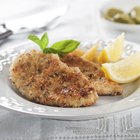
How to Cook Chicken Cutlets Without ...

How to Cook Half a Breast of Chicken
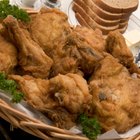
How to Par-Cook Chicken Before Frying

How to Fry Bone in Chicken
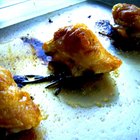
How to Cook Chicken Thighs

How to Soak Tilapia in Milk and Panko ...

Does Cornstarch Make Fried Chicken ...

How to Make Chicken & Waffles

How to Cook Chicken in Olive Oil With ...
Quick and Easy Chicken Parmesan Recipe
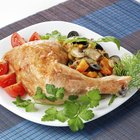
How to Cook Chicken Leg Quarters
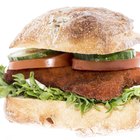
How to Cook Chicken Schnitzel

How to Barbecue Chicken in the Slow ...

How to Make Crispy Fried Chicken With ...

How to Slow Cook Brown Rice & Chicken
How to Cook Atlantic Cod Fillets

How Long Do You Need to Boil Large ...
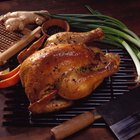
How to Marinate Roast Chicken

How to Bake Crispy Battered Chicken
Best Crock-Pot Shredded Chicken Recipe
References
Warnings
- Always cook chicken to an internal temperature of 165 F.
Writer Bio
A.J. Andrews' work has appeared in Food and Wine, Fricote and "BBC Good Food." He lives in Europe where he bakes with wild yeast, milks goats for cheese and prepares for the Court of Master Sommeliers level II exam. Andrews received formal training at Le Cordon Bleu.
Photo Credits
Jupiterimages/liquidlibrary/Getty Images